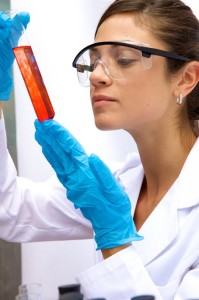
Science and Controversy

With all the controversy and bad press looming in the cosmetic industry, I thought it was important to speak as both a consumer and a cosmetic chemist. I have had the privilege of following several forum style discussions regarding the safety of cosmetics and personal care products. In these discussions, both scientists and non-scientists provide their “two cents”. Normally, a sensationalist begins the discussion with wild claims like “Women put 515 chemicals on their bodies everyday!” or “There’s lead in your lipstick and you’re eating 7 lbs of it a year!”. Think I’m being facetious? I couldn’t be more serious. Of course, this is when all the scientists join in with our facts and research, etc because we hate to see the industry being bashed and shown in a negative light.
The Scientist’s Brain
Scientists realize that consumers are often skeptical and that they are being fed a lot of misinformation. What the general public doesn’t realize is that scientists are by far the most skeptical beings… ever. Our minds are wired to question everything and believe nothing until we have seen the research or performed the research ourselves… it’s the scientific method. Once we have the facts, we will fight and argue tirelessly to inform those who don’t believe. In the case of the cosmetic industry, some of these arguments and fights occur publicly. It may appear that the scientists are picking on “the little guy”, as we often must take our stand against individuals like sales reps from MLM companies or “all natural” companies. The problem is, these individuals rarely know the science behind the ingredients that we use– both natural and synthetic.
My Note to the Consumer
Be careful what you believe. It’s perfectly ok to be skeptical, but be fair with your skepticism. I urge you to not only question claims made by the cosmetic industry, but the claims made by radicals and special interest groups as well. Keep in mind, the research and development department of any major cosmetic company is run by various scientists ie chemists, biologists, chemical engineers, etc. With the “natural” cosmetic companies, not so much. Don’t get me wrong, this post is not to bash indie beauty companies in any way. On the contrary, it is meant to bring about awareness and to say “Shame on you.” to those companies whose marketing strategy is to shed a negative light on larger, more established companies.
As with any industry, there are some snakes in the grass. There are plenty of cosmetics on the market that make claims they can’t live up to. Those products belong to both big brand manufacturers and small cosmetic companies alike. Learn to read your ingredients lists and familiarize yourself with which ingredients are natural and which are synthetic. If you want to know if a product is likely to work, feel free to ask me. Keep in mind, product claims are largely made by marketing departments, not R&D.
Final Points
1. Research shows there is no harm in parabens.
2. Water based products NEED preservatives. If you see water and no preservative, be afraid… be very afraid!
3. Preservatives are your friend… they keep your products safe from nasty little bacterial creatures.
4. Lead is not purposely included in your lipstick as a secret ingredient. Lead is a naturally occurring metal and can inadvertently be introduced to not only your cosmetics, but your food and drink as well. Albeit in TRACE amounts, as it is only found in nature in trace amounts.
5. Cosmetic Scientists use the SAME cosmetics that we market to the general public. We put them on our skin and our children’s skin. Sorry to break it to you, but there is no secret society for cosmetic scientists that makes all the “good” products that we keep to ourselves.
6. The nature of any scientist is to research, test, research, test, research some more, test and then share our findings. This is no different for the cosmetic industry.
Knowledge is Hotness, here’s to the Glam Life!

